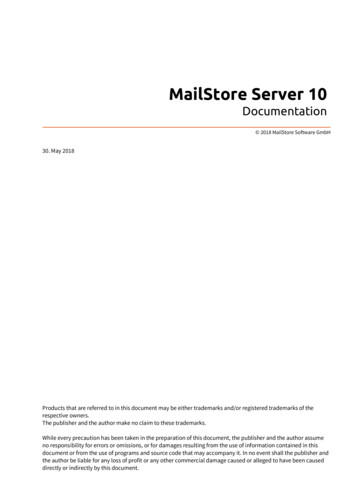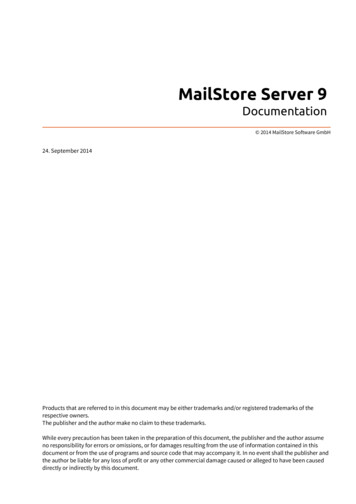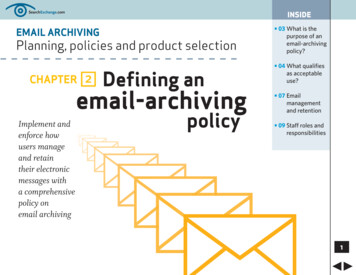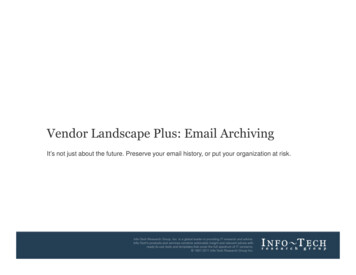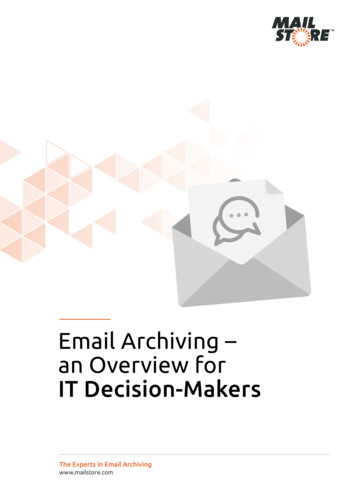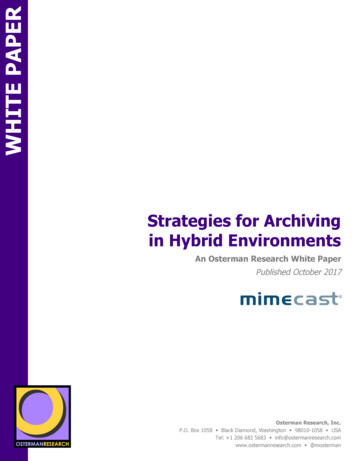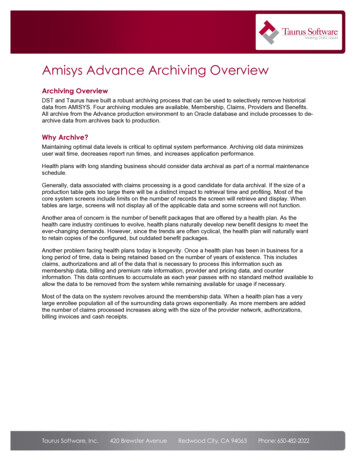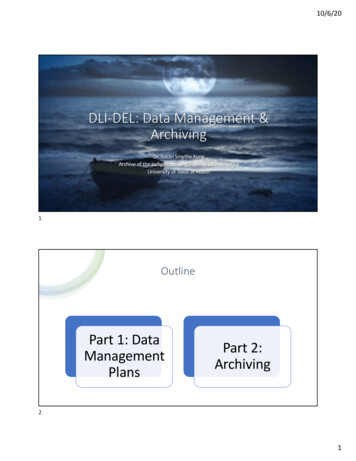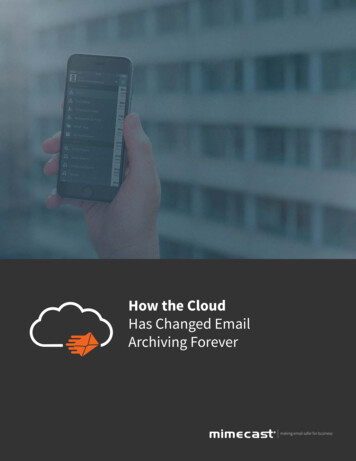
Transcription
How the CloudHas Changed EmailArchiving Forevermaking email safer for business1
IntroductionSince the 1990s, emailhas been a critical form ofbusiness communication.However, in just a couple shortThis white paper will review: The emergence of email archiving as a businessrequirementdecades, not only has email volume The challenges associated with traditionalon-premises solutionsexploded, it’s also unintentionally How the cloud has changed email archivingbecome a widespread way to store How organizations can benefit from itinformation. The convenience toemployees of an email inbox and itsuse as a personal file server poseschallenges to organizations and theirinvolved to maintain them – moreIT departments.than what most organizationsconsider ideal. Beyond complianceTo solve mailbox bloat, IT directorsand storage management, manyand CIOs have turned to emailorganizations are looking to usearchiving solutions, which havethe valuable data held in thesehistorically been difficult to manageinformation stores more actively.when the number of inboxes crossesYet legacy on-premises archives arethe 50 to 100 threshold. While emailholding them back.archiving has become critical tosatisfying legal and regulatory needs,As a result, the cloud has becomeon-premises archiving solutionsnot only a viable alternative toneed considerable storage space.on-premises storage, but hasWith growing storage requirements,dramatically changed the wayarchiving solutions require moreemail is archived.money every year, as well as oftenincreasing the amount of resources2
EMAIL ARCHIVINGas a Business NeedEmail is essential to business.The amendments to internationalHowever, the sheer volume ofregulations such as the Datait, combined with the criticalProtection Act (DPA), the Regulationinformation transmitted and stored inof Investigatory Powers Act (RIPA),emails, means that archiving is just asand U.S.-specific rules like thenecessary. According to The RadicatiFederal Rules of Civil Procedure inGroup, 112.5 billion business emails2006, specifically included electronicare generated per day, and thatcommunications under datanumber is increasing by 3% annually.protection rules and may possiblyrequire information to be produced inEmail archives are a wealth of businesslitigation matters. Further, the Enroninformation. Osterman ResearchCorp. case solidified the importancefound that 37% of business contentof electronic communications inis primarily stored in email systems,litigation when company auditorssecond only to file servers. A vastadmitted to destroying paper andmajority of all business documentselectronic documents. Enron, alonggenerated are at some point sent orwith other high-profile financialreceived as email attachments.scandals, gave way to the SarbanesOxley Act that specified how records,Since email is the numbereven electronic ones, should beone platform for businessstored and for how long.communication, it may becomenecessary to store and archive emailcommunications for compliancereasons, as well as to prepare theorganization for potential litigation.3
With email replacing other formslive email inboxes and then placedof communication, IT departmentsinto cheaper storage. Unfortunately,must be able to search archivesthis still led to higher overhead, asusing e-discovery capabilities thatthe secondary storage requirementssimplify finding specific emails andgrew at a rapid pace.aggregating information. Archivingis required in some industries withAnother issue is that just offloadingregulatory mandates, such as HIPAAhistorical email isn’t enough. Thein healthcare and FINRA that governsvalue of corporate information storedfinancial services.in emails – including documents,memos, orders, support requestsEmail is so essential for both ourand other communications withprofessional and personal lives thatcustomers, suppliers and colleaguesemployees are increasingly reluctant– shows that quickly searching andto delete emails – to the tune ofaccessing this data is critical.8,024 emails in the average mailbox.This leads to lags in performance,as employees search their emailaccounts for documents or otherinformation. On-premises archivingwas created to alleviate the problemof handling larger inboxes thanthe mail servers were designed tomanage. Emails and attachmentswere pulled off the Tier 1 storagethat had high availability anddisaster recovery required for the437% of businesscontent is primarilystored in emailsystems, second onlyto file servers
THE CHALLENGES OFTraditional Email ArchivingOrganizations turned to on-premisesQueries on on-premises archives cansolutions to manage the vasttake hours or days. Expensive on-amount of email data, but they havepremises solutions don’t always workquickly run into virtual brick walls.the way intended; these archivesComplexity, performance issues andrisk index corruption and orphanedthe staff required to maintain on-objects, creating more difficultypremises storage have made theseduring the retrieval process.solutions painful or untenable for themajority of organizations.Complexity is another problemthat on-premises storage creates.The rapid growth of email volumeA new layer of infrastructure ishas considerably slowed downadded to the email architecture andperformance in on-premises solutions.system architecture by virtue of theCompanies that are outgrowinghardware and software involved.existing hardware and otherThis requires additional resourcesresources need to purchase moreand staff. Additionally, only 10% ofservers and hire more personnel. Asorganizations provide employeesan example, one large organizationaccess to their email archives, makingpurchased 50 servers and requiresit difficult for the average employeean entire team just to maintainto retrieve information without goingthem – which is unsustainable andthrough the IT department.clearly demonstrates the limits of onpremises storage.For IT departments, it becomestime-intensive to retrieve emails,de-duplicate data and extractrelevant information for a litigationmatter or regulatory purpose.5Complexity, performanceissues and the staff required to maintainon-premises storage have made thesesolutions painful or untenable for themajority of organizations.
THE CLOUD: CHANGING EMAILArchiving for the BetterClearly, something better is neededdown as needed for the organization.for email archiving, and that’s whereIt is a true cloud solution, not acloud archives enter the picture.virtualized appliance, which can beCloud email archiving is a multi-tenantprovided with more hardware andinfrastructure that uses sharedCPU power, without increasing theresource pools and scales up andcost of the solution.There are a host of benefits tousing cloud-based email archiving:Flat cost with easy scalability: Cloud-based email archiving in amulti-tenant environment scales to the organization’s needs, allotting moreprocessing power as more data is stored. Providers offer cost models that alloworganizations to predict monthly and annual costs. Per-employee pricing is notbased on email volume or the number of mailboxes, which delivers a lower totalcost of ownership.Improved search performance and retrieval: Because cloud emailarchive providers utilize a multi-tenant environment, hardware and resourcesare provisioned to meet demand. This means searching cloud-based emailarchives does not overload infrastructure and can proceed rapidly, accessingarchived email in seconds. A true distributed grid computing architecture willsupport an end user search SLA, using the aggregated power of all servers.Self-service recoverability: Disaster recovery can be completed remotely,rather than requiring the IT team to physically repair on-premises servers. Userscan also restore accidentally deleted emails and files without requiring the ITteam to embark on a significant undertaking.6
Improved data access: Much like improved employee emailarchive access, cloud-based email archiving allows the mobileworkforce to access stored emails. This puts important businessinformation at the fingertips of those who need it. Users canaccess personal archives on any device, from anywhere. Just byvirtue of being cloud-based, an executive, salesperson or othermobile employee can quickly call up a presentation that had beenpreviously emailed. This is something that can’t be done with atraditional on-premises archive without a VPN.Clearly,something betteris needed for emailarchiving, and that’swhere cloud archivesenter the picture.Better redundancy and fault tolerance: Because cloud providers includeredundancy with their offerings, using cloud-based email archiving providesenterprise-grade redundancy to allow for easy recoverability. Cloud-based emailarchive providers use encrypted, secure servers in multiple, geographicallydispersed data centers with triplicate copies for built-in redundancy.Allows smaller companies to access powerful email archiving:The cost of on-premises email archiving, including hardware and personnel,has historically kept it out of reach of smaller companies. However, the scalablemodel used in cloud-based email archiving provides benefits to companies withmore limited resources. Also, new benefits can be realized as search and retrievalbecomes accessible to more employees from more locations.Protects against technological and human error: With all thetechnology, end users and administrators involved in the process, things will gowrong and errors will be made. Whether it’s a high-level executive who deletedan important email, or an admin who accidently deleted an account, having theability to restore to a known good point in time is both expected and critical.7
PERFECT PAIR: HOSTED EMAIL WITHCloud-Based Email ArchivingOrganizations that haveadopted solutions like Office 365For organizations that are migratingand Google Apps for Work are alreadyarchive allows them to migrate theirgetting some of the benefits of thelegacy email archives and providecloud. But just because email is in theimmediate access to historical email.cloud, it doesn’t mean that staying onImportantly, a third-party archivetop of compliance concerns, disasterprovides backup and recoverabilityrecovery and having an independentthat just isn’t part of cloud-basedbackup is less of a priority.solutions. Lastly, keeping the archiveto cloud-based email, an independentindependent from the actual emailChanging the email infrastructureservice provides greater portabilitydoes not change the businessshould a switch in providers becompliance and litigationnecessary in the future.requirements, and having thosearchives and forensic trails will becritical in the event of a lawsuit orregulatory audit. Cloud-based emailarchives provide comprehensivecompliance, e-discovery and litigationsupport, such as legal hold, casemanagement and data export. Thesesolutions also deliver completearchive access logging, includingsearches and message views.8Changing the emailinfrastructure does notchange the businesscompliance andlitigation requirements.
ConclusionCloud-based email archiving does more than just provide a wayto store old emails. It provides a new way to search and retrieve emails,offers reliable disaster recovery and redundancy, plus audit trails to help staycompliant. It scales with business needs and provides fast search results inseconds for employees both in and out of the office.To learn more about Mimecast’s cloud-based email archivingoptions, visit www.mimecast.com or call 800-660-1194.About MimecastMimecast makes business email and data safer for thousands of customers and millionsof employees worldwide. Founded in 2003, the Company’s next-generation cloud-basedsecurity, archiving and continuity services protect email, and deliver comprehensive email riskmanagement in a single, fully integrated subscription service. Mimecast reduces email risk andthe complexity and cost of managing the array of point solutions traditionally used to protectemail and its data. For customers that have migrated to cloud services like Microsoft Office 365 ,Mimecast mitigates single vendor exposure by strengthening security coverage, combatingdowntime and improving archiving.Mimecast Email Security protects against malware, spam, advanced phishing and other emergingattacks, while preventing data leaks. Mimecast Mailbox Continuity enables employees to continueusing email during planned and unplanned outages. Mimecast Enterprise Information Archivingunifies email, file and instant messaging data to support e-discovery and give employees fastaccess to their personal archive via PC, Mac and mobile apps.To learn more, visit www.mimecast.com.9
the 50 to 100 threshold. While email archiving has become critical to satisfying legal and regulatory needs, on-premises archiving solutions need considerable storage space. With growing storage requirements, archiving solutions require more money every year, as well as often increasing the amount of resources involved to maintain them - more
